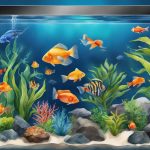Hey there, fellow aquarium enthusiasts! If you’re like me, you want to provide the best care for your beloved aquatic friends. That’s why I’ve put together these best practices for ensuring aquarium fish health. By following these maintenance tips, you can create a thriving underwater oasis for your fish to thrive in.
Proper aquarium fish health care is essential to their well-being. Just like any living creature, fish require specific conditions to stay healthy and happy. From acclimating your fish to maintaining water quality, every aspect matters in creating the optimal environment.
Key Takeaways:
- Regular maintenance of your aquarium is crucial for the health of your fish.
- Properly acclimating your fish to the water helps minimize stress.
- Water quality plays a vital role in fish health, so monitoring and testing is key.
- Identifying and addressing cloudy water issues is essential for maintaining a clean and healthy tank.
- By following these best practices, you can ensure the well-being and longevity of your aquarium fish.
Now that you’re equipped with these best practices, let’s dive in and explore each aspect in more detail. Your fish will thank you!
Acclimating Your Fish to the Water
Properly acclimating your fish to the water in your aquarium is essential for their well-being. The process of acclimation allows the fish to gradually adjust to their new aquatic environment, reducing the risk of stress and potential health issues.
Here are some tips to help you acclimate your fish to the aquarium water:
- Prepare the Water: Before introducing your fish to the aquarium, ensure that the water parameters are suitable for their species. Conduct regular water chemistry testing to monitor and maintain optimal conditions.
- Drip Acclimation: The drip acclimation method is highly recommended for sensitive or delicate fish species. Start by floating the fish in a plastic bag or container on the surface of the aquarium water. Then, gradually add small amounts of aquarium water into the bag over a period of 30-60 minutes. This slow introduction allows the fish to adjust to differences in temperature, pH, and other water parameters.
- Float and Release: For hardier fish species, the float and release method can be used. Simply float the sealed bag containing the fish in the aquarium for around 15-20 minutes to equalize the temperature. Then, gently release the fish into the water. Take care not to transfer the water from the bag into the aquarium, as it may contain harmful substances.
- Observe and Monitor: After acclimation, closely observe the behavior and condition of your fish. This will help you identify any signs of stress or illness. If you notice any abnormal behavior, such as excessive hiding, loss of appetite, or physical abnormalities, seek appropriate veterinary care.
Remember, each fish species has its own specific acclimation requirements, so be sure to research the needs of your particular fish before proceeding. By following these acclimation tips and regularly testing the water chemistry, you can provide a smooth transition for your fish and promote their overall health and well-being.
| Common Fish Acclimation Methods | Pros | Cons |
|---|---|---|
| Drip Acclimation | – Allows gradual adjustment – Effective for sensitive fish species |
– Requires more time – Can be challenging for beginners |
| Float and Release | – Quick and easy method – Suitable for hardy fish species |
– May not be suitable for sensitive fish – Risk of transferring water from the bag |
Maintaining Water Quality in Your Aquarium

Regular maintenance of the water in your aquarium is crucial for the health of your fish. By following these guidelines for aquarium water maintenance, water change frequency, and cleaning the tank, you can help create a clean and thriving environment for your aquatic pets.
Aquarium Water Maintenance
Proper aquarium water maintenance involves monitoring and adjusting key parameters to ensure a stable and healthy environment for your fish. Test the water regularly for pH levels, ammonia, nitrite, and nitrate levels using reliable testing kits. Maintain the appropriate water temperature for your fish species, as different fish have different temperature requirements.
In addition, ensure proper filtration in your aquarium. A high-quality filter will remove debris and toxins, keeping the water clean and oxygenated. Follow the manufacturer’s instructions for filter maintenance, such as cleaning or replacing filter media.
Water Change Frequency
Regular water changes are essential for maintaining optimal water quality. The frequency of water changes depends on various factors, such as tank size, fish species, and the number of fish in the aquarium. As a general guideline, perform partial water changes of about 25% to 50% every 1 to 2 weeks.
“Regular water changes are essential for maintaining optimal water quality.”
During water changes, siphon out debris, uneaten food, and excess waste from the substrate. Be careful not to disturb your fish or beneficial bacteria colonies in the process. After removing the old water, replace it with dechlorinated water of the same temperature as the aquarium.
Cleaning the Tank
In addition to regular water changes, it’s important to clean the tank itself to prevent the buildup of algae, biofilm, and other contaminants. Use an algae scrubber or a non-abrasive aquarium cleaning pad to remove algae from the glass or acrylic surfaces.
During tank cleaning, also check and clean any decorations, rocks, and plants in the aquarium. Remove any excess debris or decaying plant matter to maintain a clean and aesthetically pleasing environment for your fish.
“Use an algae scrubber or a non-abrasive aquarium cleaning pad to remove algae from the glass or acrylic surfaces.”
Remember to never use soap or cleaning agents that may be toxic to your fish when cleaning the tank. Rinse any equipment or decorations thoroughly with dechlorinated water before placing them back into the aquarium.
| Benefits of Water Quality Maintenance | Consequences of Poor Water Quality |
|---|---|
|
|
Troubleshooting Cloudy Water in Your Aquarium
Dealing with cloudy water in your aquarium can be frustrating, but understanding the causes and finding appropriate solutions is essential for maintaining a healthy environment for your fish. Here are some common culprits behind cloudy water and how to address them:
1. Overfeeding and Poor Water Quality
Overfeeding your fish can lead to excess waste and nutrient buildup in the water, which can cause cloudiness. Ensure you are feeding your fish the appropriate amount and regularly test the water parameters to maintain optimal conditions. Performing regular water changes can help manage the problem.
2. Improper Filtration
An inadequate or faulty filtration system can contribute to cloudy water. Make sure you have the right type and size of filter for your aquarium, and clean or replace the filter media regularly to prevent clogs and maintain proper water flow.
3. Insufficient or Inconsistent Water Changes
Infrequent or insufficient water changes can result in a buildup of waste, uneaten food, and other substances in the aquarium, leading to cloudiness. Aim to perform regular water changes, typically around 10-15% every 1-2 weeks, to help maintain water clarity and quality.
4. Presence of Suspended Particles
If your water appears cloudy but doesn’t seem to be caused by any of the above factors, it may be due to suspended particles. These can include uneaten food, fish waste, and debris. In this case, using a good quality mechanical filter or a fine filter media can help remove the particles and restore clarity to the water.
By identifying the causes of cloudy water in your aquarium and implementing the appropriate solutions, you can ensure a clean and healthy habitat for your fish to thrive in.








